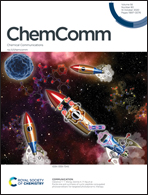Insight into hydroxyl radical-mediated cleavage of caged methylene blue: the role of Fenton's catalyst for antimalarial hybrid drug activation†
Abstract
Methylene blue with a 10-N carbamoyl linkage was reported to be a hydroxyl radical triggered cleavable ligand. Probed by this platform, hemoproteins were demonstrated to be a much more efficient Fenton's catalyst than commonly used inorganic Fe(II) salts. The applicability of this ligand was demonstrated through the capability of being triggered by elevated reactive oxygen species levels at diseased tissue, with malaria-parasitized erythrocytes as an in vitro model.



 Please wait while we load your content...
Please wait while we load your content...